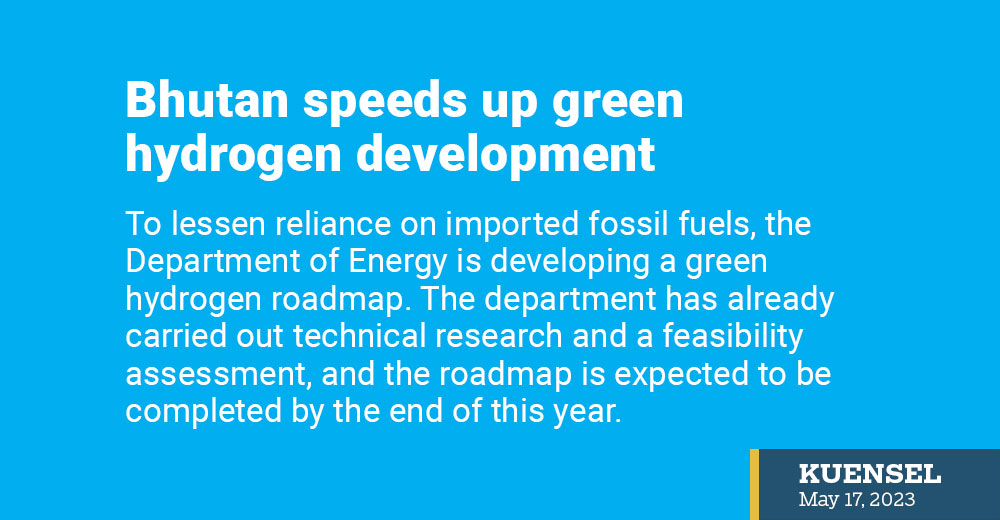Thukten Zangpo
To lessen reliance on imported fossil fuels, the Department of Energy is developing a green hydrogen roadmap. The department has already carried out technical research and a feasibility assessment, and the roadmap is expected to be completed by the end of this year.
According to department officials, the roadmap will detail the necessary procedures and milestones for the development and integration of hydrogen as a key energy carrier across numerous industries, particularly in the transportation sector. It will serve as a model for governments, industry, and stakeholders to follow in order to coordinate efforts and investments in the hydrogen economy.
Bhutan is well-suited for creating green hydrogen through electrolysis since it has abundance of renewable energy sources, especially hydropower. Hydrogen fuel provides a steady and dependable source of electricity that may be used in a variety of industries, including mobility, industrial, and power generation.
Bhutan’s decision to concentrate on green hydrogen is consistent with the country’s aim to carbon neutrality and sustainable growth. The greenhouse gas inventory confirmed the country’s carbon neutral position, with emissions of 3.8 million tonnes of carbon dioxide equivalent (CO2e) in 2015, offset by sequestration of 9.4 million tonnes of CO2e. Bhutan exceeded the Paris Agreement’s carbon-neutral goal, reaching a net carbon sink balance of 5.6 million tonnes of CO2e.
According to a study, Bhutan’s energy consumption will be more than sixfold, and oil demand will more than sevenfold by 2050, with the transportation sector being the major emitter of greenhouse gases under business-as-usual conditions. Bhutan, on the other hand, can retain its carbon neutrality until 2050 by cutting oil demand in the transportation sector and encouraging the use of electric vehicles and public transportation.
Bhutan’s second Nationally Determined Contribution (NDC) describes the need for USD 3.44 billion in investments until 2030 to combat climate change and fulfill its climate goals.
Furthermore, Bhutan has the opportunity to reduce its reliance on imported fuel by manufacturing hydrogen domestically, improving energy security.
Bhutan purchased Nu 11.37 billion in gasoline from India last year, up from Nu 8.35 billion in 2021.
Hydrogen, like natural gas, petroleum, and liquid petroleum gas, is capable of being stored and delivered via pipelines, tankers, and hydrogen trailer vehicles.
Pipelines, however, may not be the most viable choice due to Bhutan’s geographical limitations. Tankers and hydrogen trailer trucks, for example, could play an important role in the transportation and storage of hydrogen.
Because of variables such as high capital costs of equipment and limited economies of scale in hydrogen production, the cost of hydrogen fuel is now higher than that of traditional fossil fuels.
However, the Department of Energy believes that as technology progresses and economies of scale are reached, hydrogen will become more economical and competitive with fossil fuels.
A fuel cell SUV, for example, can go roughly 90 km using only 1 kilogram of hydrogen, but a petrol-powered SUV would take approximately 6-7 liters of gasoline to cover the same distance.
The price of hydrogen for Bhutanese customers would be determined by local market conditions, infrastructural development, and government policies supportive of the hydrogen economy, according to the department officials.
There are several advantages to using electricity for hydrogen production, including the integration of renewable energy sources and energy storage. Hydrogen production through electrolysis provides an avenue for incorporating wind and solar energy into the electricity grid.
The use of electricity for hydrogen synthesis has various advantages, including the use of renewable energy sources and energy storage. Electrolysis produces hydrogen, which can be used to integrate wind and solar energy into the power system.
As Bhutan finalises its green hydrogen programme, the government also plans to produce 700MW of solar electricity, 3MW of biomass, and 50MW of wind energy by 2032. The country has a solar energy capacity of 12GW and a wind energy capacity of 760MW. India started the Hydrogen Mission of India in early 2023, emphasising the global transition to low carbon intensity and reduced reliance on fossil fuel imports.
According to the Hydrogen Council, hydrogen has the potential to meet up to a fifth of the world’s energy needs and create a USD 2.5 trillion industry by 2050.
The growing global demand for green hydrogen reflects countries’ and businesses’ efforts to decarbonise their energy sectors and minimise greenhouse gas emissions. Countries across Europe, including Germany, the Netherlands, and Spain, are developing hydrogen policies and setting targets for hydrogen production and consumption.
Similarly, in Asia, Japan, and South Korea have expressed strong interest in green hydrogen to minimise their reliance on fossil fuels and attain carbon neutrality targets.


